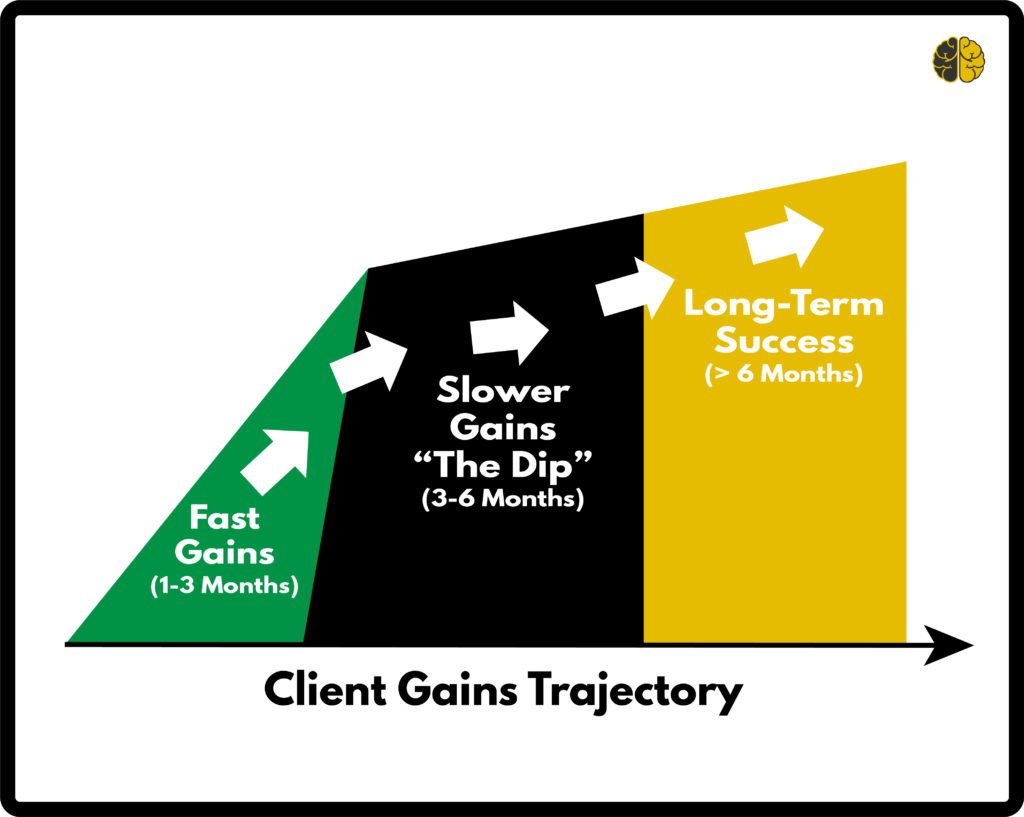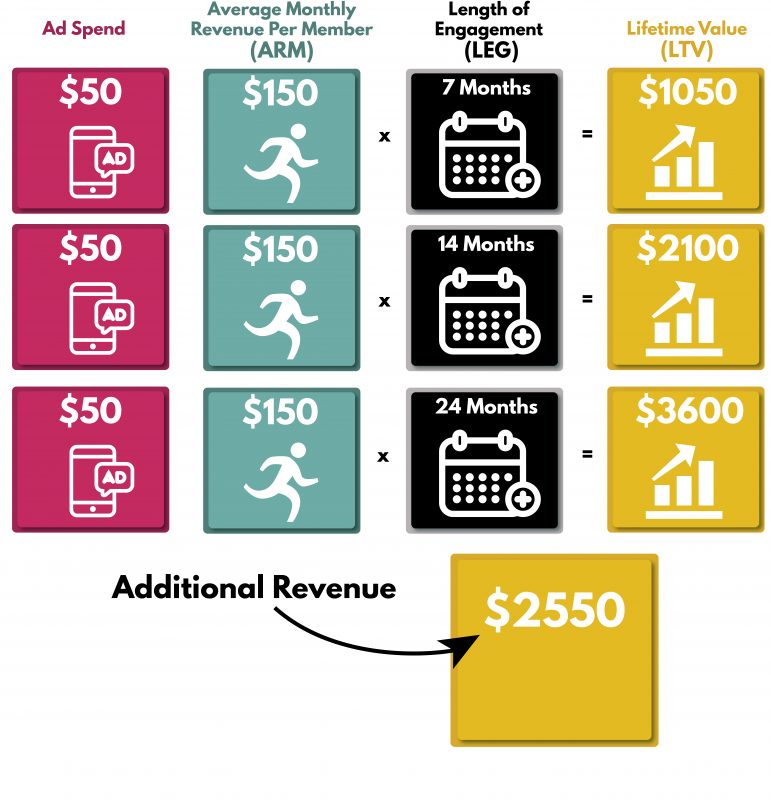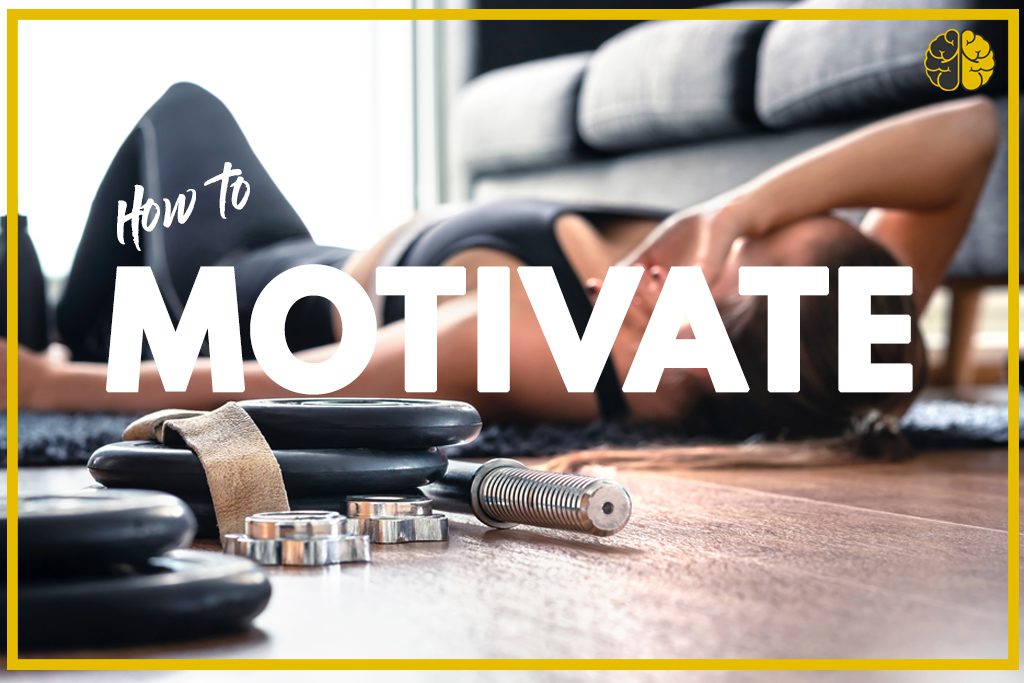How do you know when someone has recently started working out?
Don’t worry: They’ll tell you.
New exercisers and dieters are quick evangelists: They feel great and want everyone around them to feel the same way. Kudos to them.
In the beginning, gains come quickly and PRs are everywhere.
But then—you know what happens next. Within three to six months, PRs don’t come in every workout.
“What do you mean we can’t just bench press three times per week?”
They start cherrypicking the workouts, then they start finding “hacks” to their diets (remember paleo brownies?). Then they start looking for novelty (“What do you think about this dude’s programming?”).
It’s frustrating for coaches because results compound exponentially instead of incrementally. Clients don’t really improve their fitness by 1 percent at every workout; instead, results come quickly at first, then taper down, but, over time, their tiny marginal gains snowball into long-term change.
This is “the dip”—really just a transitional period from rapid to slower improvement.

We all know what it’s like to watch a client hit the dip. The honeymoon is over, but the long-term gains haven’t really begun.
Today, I’m going to tell you how to get clients through the dip and why it’s worth the extra effort.
The Dip and the Data
We’re all addicted to novelty. This is why six-week or 75-day challenges are so popular—and so effective when they start. It’s also why people often fail to complete the challenges or why they fail to convert to a long-term gym membership after the challenge ends.
Two years ago, the average microgym kept a client for 13.1 months. Today, that number is more like 7.8 months.
There are a number of reasons why the number has changed, but the biggest factor is the rise of the short-term challenge. Clients sign up for a gym’s six-week challenge and then leave when it’s over. And six-week challenges also push out long-term members who have to share coaches and resources with a constant flow of newbies in their classes.
This is really important because it costs a lot to get new clients, and that local pool of clients is limited.
Here’s the kicker: Our data shows that if you can get the client past the eight-month mark, you’ll probably keep them for 14 months. That’s an additional six months of revenue for the same cost of acquisition. More importantly, that’s six more months of compounding results for the client.
And if you can keep them past that 14-month mark, you can probably keep them for 24 months!
The Math
For example, let’s say your average client pays $150 per month.
You pay $50 in ad spend to attract them and sign them up.
$150 x 7 months = $1,050 lifetime value (LTV).
But if you can keep them around through the dip, that multiplier goes up to 14 months—with no additional marketing cost.
$150 x 14 months = $2,100 LTV.
And if you can get them past the 14-month mark, their LTV usually shoots up to $3,600 ($150 x 24 months).
That’s an extra $2,550 per client—and more if you’re a Two-Brain gym because your average revenue per member is a lot higher!
There’s a lot on the line here.

Surviving the Dip: Your Action Plan
Data proves this is the best way to set up a client for success, get them through “the dip, and keep them long term:
1. Adopt the Prescriptive Model. I’ll walk you through that step-by-step on Thursday’s podcast.
2. At a client’s No Sweat Intro, break goals down into the smallest steps possible. Read about the process here. Or watch this video:
3. Set up the client’s first four to six weeks as their own personal “challenge.” Not a group challenge, but you can include group attendance in the challenge if you want to. This is your onboarding process or on-ramp or whatever you want to call it. But it’s far more than just teaching people how to squat. Here’s how Brian Zimmerman does it: Two-Brain Radio: Make More Money for Years.
4. Set up a meeting to occur a week before the end of their personal challenge. This is called a Goal Review Session.
5. At that meeting, highlight successes, find Bright Spots, measure progress, and make the next prescription.
6. Sign them up for the next phase before the current phase ends. Build a bridge before you reach the dip.
7. Book their next Goal Review for three months out. You should have completed three meetings (No Sweat Intro, Goal Reviews 1 and 2) before the seven-month mark.
8. Measure your retention and revenue improvements in the Two-Brain Dashboard. Track your progress and compare against other gyms (Two-Brain clients only).
Yes, there’s money involved. But the truth is that you can’t change anyone’s life in seven months. You must keep clients around for years if you want to dramatically change their health. That’s why it’s so critical to get them through the dip: If you don’t, they’ll just keep starting and failing forever.
Other Media in This Series
How to Motivate People
How to Motivate People: The Start
Motivation: The Dark Secret

